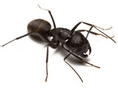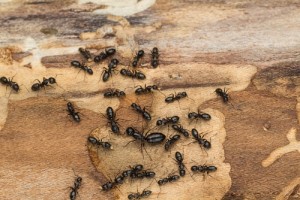
The Carpenter Ant is a common invader of homes in the North East. They do not eat wood, but they are capable of excavating wood to provide nesting or shelter.
The debris discarded from exit holes is usually the only obvious indicator that a carpenter ant problem is present. They are attracted to wood that has been previously damaged by water.
They have several different castes. There are winged females and winged males, the female is bigger. The worker ants come in three sizes, minor, intermediate and major worker.
These ants are our largest, native ant species, with the winged Queen ants maturing to nearly 1 inch in length. A parent colony or main colony is almost always outside. Workers from these large parent colonies will forage up to 700 feet away.

They can move into a structure and establish satellite colonies. While the ants in your home don’t always establish a satellite colony, they can still be in great numbers foraging for food or shelter.
The key to eradicating these pests is knowing their biology and habits, and having the proper tools and materials. Here at Yale we have been successfully handling these troublesome pests for more than 30 years.
With carpenter ant treatments there is almost always contributing factors that can aid the ants in infestation. We need a certain amount of cooperation from the homeowners.
To name a few items: keep gutters free of debris, Store firewood off the ground, away from the house and covered. Fix and repair all leaks and moisture problems; damp wood is very attractive to the ant.
Additionally, keeping trees and vegetation cut back away from the structure to prevent the ants from bridging our barrier treatment and gaining access to the structure is also a factor that lessens the risk of infestations.
Yale Pest Elimination offers two different treatments for Carpenter ants. If Carpenter ants are the only pest problem we offer a one-time treatment with a one-year warranty. If you have other pest problems through out the year Yale offers a bi-monthly service plan that covers many of your common pests.